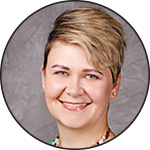
Am Fam Physician. 2023;107(6):651
Author disclosure: No relevant financial relationships.

7:15 a.m.
I start my day giving a lecture about appendicitis to the residents on our inpatient pediatrics service. While leaning heavily on the last review article in American Family Physician, they also want perspective from my 15 years in rural private practice.
7:45 a.m.
I see a patient who followed me from private practice. She comments on how young the residents look and concludes with a wink, “just like you used to.”
10:30 a.m.
I see a new 95-year-old patient and his family. His evolving dementia led his family to seek advice about medication deprescribing. His children are pleased to see the statin, amitriptyline, and supplements come off his medication list, and we plan to talk at his next visit about his SSRI and PPI.
12:30 p.m.
Our noon lecture is a point-of-care ultrasound presentation using our mobile device–connected ultrasounds. I'm sure I'm learning more from the residents than they are from me. I guess you can teach an old dog new tricks!
2:00 p.m.
One of the residents is having trouble finding fetal heart tones on a patient and asks for help. I give a few pointers, and the resulting thump-thump-thump of the baby's heartbeat brings a sigh of relief to both the mother and the resident.
4:30 p.m.
During my monthly county board of health meeting, a resident participating online sends me a text that says that she can't imagine the board getting any work done without a family doctor at the table. Agreed!

7:30 a.m.
I arrive at the hospital to discharge a mother and baby at 30 hours of life. My patient had a retained placenta that required manual removal, but they are anxious to leave the hospital. I reassure them that they can contact me if the mother develops any fevers, foul vaginal discharge, or abdominal pain.
8:30 a.m.
I receive a message from a patient who had COVID one month ago and was treated with nirmatrelvir/ritonavir (Paxlovid) but has ongoing severe fatigue and dyspnea on exertion. Her lungs were clear last week with mild tachycardia and normal oxygen saturation. I order chest radiography, d-dimer level, complete metabolic panel, and complete blood count.
9:00 a.m.
Our clinic is short-staffed, so most of my day is filled with telemedicine. Today I see patients with COVID, vertigo, hypertension, diabetes mellitus, chronic pain, ADHD, menopause, and a UTI.
3:30 p.m.
I follow up with a patient who was discharged this weekend after treatment for multiple hepatic abscesses from a perforated appendix. Last week, I organized STAT imaging for his abdominal distention, fever, and low appetite. He thanks me for insisting that he get same-day imaging.
4:00 p.m.
I perform a vasectomy for a man who is concerned about the abortion law changes and doesn't want to cause a pregnancy. We discussed the irreversibility of the procedure during his pre-op visit, but I ask him again if he has any concerns before I start. We listen to old-timey folk music and chat during the procedure.
7:00 p.m.
The d-dimer result from the patient earlier today is 1,300 ng per mL. Because the patient is hemodynamically stable and has had symptoms for several weeks, I order a STAT computed tomography pulmonary angiogram of her chest for the next day. Because she likely has a pulmonary embolism, this is a risky move, but we discuss the benefits of avoiding a crowded, understaffed ER during the pandemic.
